Clematis Tangut - varieties and secrets of cultivation
Clematis Tangut (lat.Clematis orientalis var. Tangutica) is a typical representative of the Asian flora. It grows in the forests of Mongolia and China in the form of small bushes, rarely exceeding 30 cm in height. Later, several types of flower were bred by breeders. The most famous of them is a variety with the telling name "Love Radar".
- Description of the variety
- Varieties
- Landing features
- Seat selection
- Preparation of planting material
- Landing technology
- Care
- Watering
- Top dressing
- Loosening and mulching
- Cropping (cropping group)
- Shelter for the winter
- Reproduction
- Seeds
- Layers
- Cuttings
- By dividing the bush
- Diseases and pests
- Powdery mildew
- Gray rot
- Rust
- Wilt
- Aphid
- Gall nematode
- Use in landscape design
- Testimonials
- Useful videos
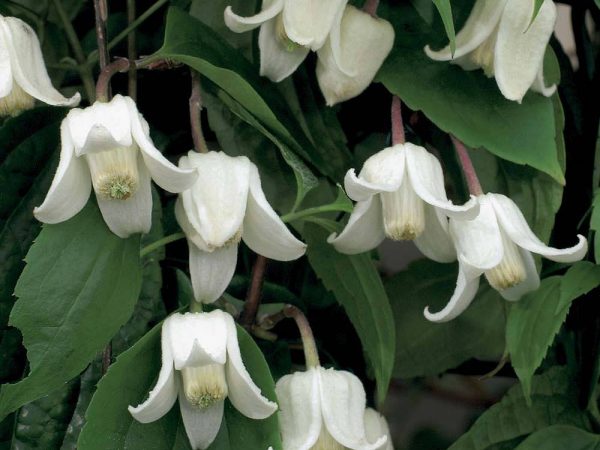
Clematis Tangut
Description of the variety
Oval-shaped leaves are attached to the stems with long curved cuttings. They are of an unusual emerald color that changes over the course of the season. They are located rarely, in pairs.
Lianas are thin, herbaceous, their bark remains tender even in old bushes, it does not stiffen.
The flowers of the Tangut clematis (clematis) are yellow-orange drooping bells or Chinese lanterns. They cover the liana abundantly and look contrasting against the background of green foliage.
They bloom only on the shoots newly regrown after winter. Each bud has 4 petals that never fully open. The diameter of the flowers is 3-4 cm, up to 100 of them are formed on each liana.
The flowering period is from May to October. Sometimes it stops, but then it starts again. After the buds wither, decorative seed pods remain in their place. They are often used to create floristic compositions.
Varieties
Tangut clematis is a species that combines several different artificially bred varieties. Let's consider the most famous ones.
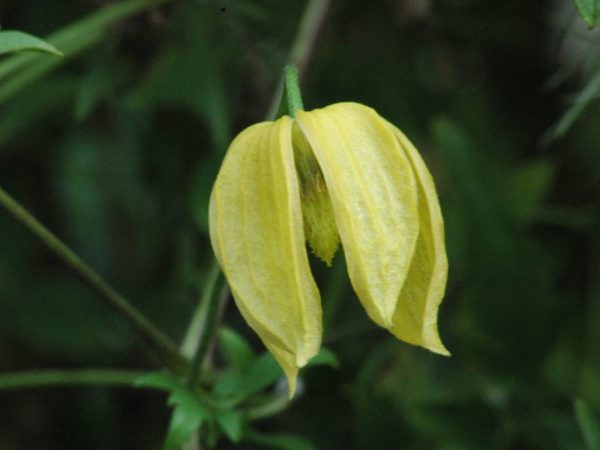
Clematis Tangut love radar
Love radar - has small bright yellow flowers in the form of bells. The height of the bush is up to 3 meters.
Anita - flowers are white, numerous, bloom twice a year - in June and September. Vines reach a height of 3-3.5 meters.
Aureolin - yellow bells bloom on a small bush. Their diameter is up to 3 cm, each liana has up to 120 buds.
Golden Falls - the flowers are bright yellow, their diameter is 6 cm. This is the largest-flowered variety of the Tangut clematis. The height of the bush is up to 4 meters.
Cotton candy - flowers are pale, lilac-gray, with thin hanging petals, from a distance they resemble a fluffy ball.
Bill mackenzie - the tallest variety. It has yellow flowers that bloom from May to September. The shrub height can reach 5-6 meters. It is often used in the design of gazebos and decorating the facades of houses.
Grace - medium-sized, but very decorative variety. The flowers are beige immediately after blooming, then they acquire a pinkish tint. The 3.5 meter high bush looks beautiful and unusual.
Lambton park - the bush reaches 4 meters. The flowers are large, up to 5 cm in diameter. Not demanding on lighting, can grow in the shade. The flowers are brownish-yellow, small, half-open.
Last Dance. The variety blooms long and profusely with yellow-orange bells.It quickly braids any support, the height of the bush is up to 4 meters.
Each of the varieties can actually be grown from seeds in 1-2 years. The plant generally multiplies easily, quickly starting to bloom. To design a site, you need to think in advance for what purposes the vine will be used. The variety is selected based on the height of the bush.
Landing features
Planted both in early spring and throughout the fall. The species is winter-hardy, easily tolerates frosts down to -35 0С. When planting in spring, you need to try to be in time until the leaves begin to bloom on the seedling. During the period of swelling of the buds, it is easier for the plant to take root. This clematis will bloom a year later.
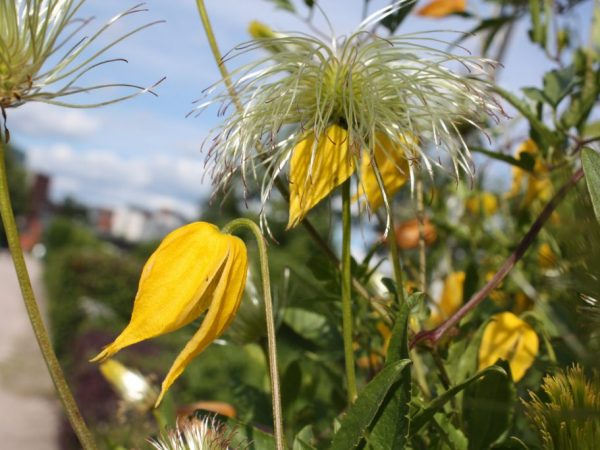
Clematis Tangut planting and care photos:
Autumn planting is more reliable, provides early flowering of the bush.
It is allowed to transfer seedlings to open ground from September to the end of October, depending on the climatic zone. The main thing is that from planting to frost there should be at least 3 weeks for rooting. Then the plant will take root and can bloom next year.
Seat selection
The place should be well lit, but the bush should not be in direct sun all day. A little partial shade for at least 4-5 hours will be ideal.
It is better to plant a plant near walls, which will simultaneously serve as a support and protection from the scorching sun and wind. The main thing is to retreat 50-60 cm when planting so that the roots develop normally.
The distance between the bushes should not be less than 1 meter.
When choosing a landing site, you need to take into account the depth of the groundwater. If they are close to the surface, it is better to look for another area. If there is no choice, then you will have to make a deep hole with multilayer drainage to prevent root rot.
Preparation of planting material
The seedlings must be healthy, otherwise it will not work to grow a full-fledged flowering bush. The root system should consist of at least three roots 10-15 cm long.
When buying, it is advisable to check the roots by lightly rubbing one of them with your fingernail. If white flesh is visible inside, the root is healthy.
Shoots are also checked for growths, spots, fluffy plaque, cracks and wounds - their presence indicates that the plant should not be planted on the site.
Better to put it in a flowerpot and keep it in quarantine indoors until next season. In parallel, the seedling is treated with the necessary preparations (depending on the problem). The next year, a healthy young clematis is planted in the garden.
Landing technology
First, prepare a hole for a bush. It is better to do this in advance - 1.5-2 months before planting. During this time, the soil will settle, acquiring the desired structure. Drainage must be poured at the bottom. Its thickness depends on the proximity of groundwater: the closer they are, the more multilayered the drainage.
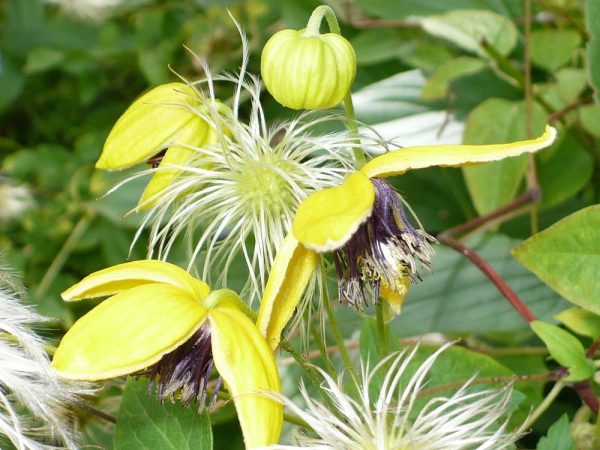
Clematis Tangut cotton candy
As it is used:
- broken red brick;
- stones;
- clay shards;
- large expanded clay;
- gravel;
- coarse sand.
The layers are stacked in this order - from large to finer. The soil is poured next. Its composition looks like this:
- nutritious leafy soil (universal flower soil);
- peat;
- humus;
- compost;
- ash;
- dolomite flour (with increased soil acidity).
Important! Acidic soils are not suitable, clematis does not bloom on them, it gets sick and loses leaves. The soil must be neutralized as much as possible with ash and dolomite flour. The procedure is repeated every year in the spring, otherwise the soil parameters will return to their previous values.
The seedling is transferred to the pit, the roots are straightened. Sprinkle with earth on top, slightly shaking the trunk (this way the soil is evenly distributed between the roots). The root collar should be 10-15 cm deep underground. The pit is watered, the soil around the bush is mulched with hay, straw, sawdust, peat.
Care
Unlike artificially bred species, Tangut clematis grows safely in nature, even in the most remote northern regions. It easily tolerates winter, disease resistant.The only way to ruin a plant is by improperly selected conditions and mistakes in care.
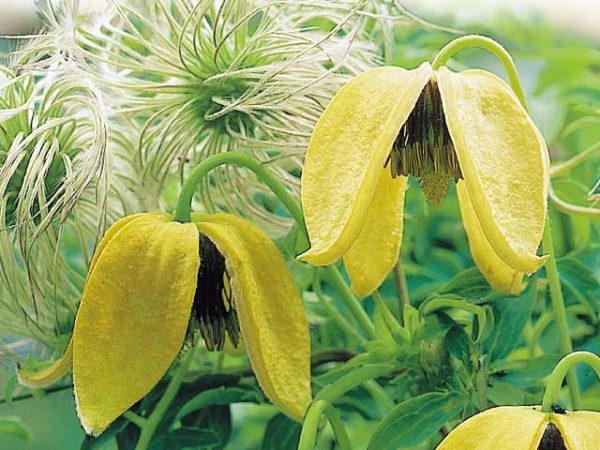
Clematis tangut chinese lanterns
Watering
Seedlings of the first year of life are watered 2-3 times a week with settled water. The ideal option is rainwater, which is better absorbed by the roots. If the summer is rainy, the irrigation regime changes.
An adult bush needs 25-30 liters of water per watering, a young one is enough for one bucket.
It is impossible to overdry the earth - its surface roots suffer the most. Without a healthy root system, it will be unrealistic to achieve a lush flowering of the bush.
Top dressing
Even the most fertile soils will not be able to provide the plant with all the nutrients required for long flowering and green mass growth.
In the spring, nitrogen fertilizers are applied:
- Nitrate;
- Ammonia;
- Ammonium nitrate;
- Amide (urea and calcium cyanamide).
Phosphorus is needed closer to summer. It participates in all metabolic processes, increases frost and drought resistance. Without it, the accumulation of sugar, starch and fat in the cells does not occur, without which the plant dies.
Fertilizers with a high phosphorus content:
- Ammophos;
- Diammophos;
- Superphosphate;
- Precipitate;
- Phosphorite (or bone) meal.
Potassium also needs to be applied in the middle of summer. Its main property is to increase the immunity of plants, their resistance to diseases. Fertilizers:
- Potassium nitrate;
- Potassium chloride;
- Kalimagnesia.
At the end of summer, organic matter is introduced into the soil - manure or bird droppings. They should be dry, rotted, preferably 2-3 years old. The same manure is later used to fertilize the bush before wintering. This is both a power source and plant insulation.
Loosening and mulching
Clematis roots are located close to the surface. They need to breathe, so the soil in the trunk circle is regularly loosened. In this case, the main thing is to be careful not to damage the delicate roots. The second important procedure is mulching (to protect the root system from the sun and drying out).
Not only hay, straw, needles or sawdust are used as mulch. Low-growing annuals are also planted right under the bushes. They will prevent weeds from germinating and will also protect you from the scorching sun.
Herbs such as calendula and marigolds serve to repel harmful insects. They should not be weeded out in the fall, leaving them on the soil as a useful humus.
Cropping (cropping group)
The Tangut clematis trimming group is the third. This means that in the fall it is necessary to remove all old shoots down to the lower three or four buds - in this case, you can really count on a lush flowering next year.

Clematis Tangut seeds
You can trim the bushes not only in autumn, but also in early spring, but the first option is preferable.
During the summer, the bush also needs sanitary pruning - a cut of withered, weakened, broken shoots. This prevents thickening of the bush, allows leaves and buds to receive more light and fresh air. Timely removal of diseased shoots will save the entire bush from infection and even death.
Shelter for the winter
Despite the resistance of the Tangut species to cold weather, it is still recommended to cover it. First of all, young bushes protect from frost. They are covered with peat, spruce branches or dry foliage. A non-woven material and a film are laid on top.
You can cover the plant with a small wooden box, and already on top with a film. An air gap forms inside, which, in the presence of a thick layer of snow at the top, will function as a greenhouse. The main thing is to remove this shelter in time in the spring, so as not to steam the plant.
Reproduction
Clematis Tangut, unlike the others, is most often propagated by seeds. Their high percentage of germination and a quick set of green mass allows you to get a full-fledged plant in 1-2 years. Clematis is also propagated vegetatively.
Seeds
Before sowing, the seeds are usually soaked in warm rainwater for a day. Then they are placed in a substrate: sod land, coarse sand, crushed chalk.They are placed at a distance of 3-4 cm from each other, so as not to immediately resort to a pick.
The container should be placed in a dark, cool place with a temperature of + 13-15 ° C. This is a prerequisite for the germination of clematis seeds. Seedlings appear in 3-4 weeks, after which the container is immediately transferred to the light and begins to warm. Seedlings are watered from a spray bottle, and not under the root.
Clematis grows very quickly. When 7-8 leaves appear, the seedling can be transferred to the greenhouse on the site. So the young plant will spend the first year of its life, after which it will "move" into the open ground to a permanent place. With seed reproduction, the Tangut species blooms already 2-3 years after planting.
Layers
In summer, the shoot is bent to the ground and fixed with a stone, sprinkled with earth on top, leaving the top on the surface. Water the cuttings regularly until it takes root completely. This usually happens after 1-2 months, but it is impossible to separate the shoot immediately. He must gain strength to be able to feed on his own.
For the first winter, the layers are left with the mother bush. Then in the spring, as soon as they begin to swell almost on the shoots, the layers are separated and planted in a new place. It immediately grows, and the next year it blooms, retaining all varietal properties.
Cuttings
You can harvest material for cuttings in the fall, but it is better to do this in early spring. From one young shoot, several full-fledged cuttings with 3-4 buds are obtained at once. They are rooted in a nutrient substrate. This usually takes 4-5 weeks. Then the seedlings are transferred to a greenhouse or derazht at home until next year.
By dividing the bush
Dividing a bush is a way not only to reproduce it, but also to rejuvenate it. He is subject to old clematis from 6 years old, which dig up and cut the roots into several parts. Sections are treated with fungicides and filled with warm wax to prevent infection.
Each individual bush is planted on a plot at a distance of 70 cm from each other. The old bush with the main root is returned to its original place. The soil underneath is renewed by adding nutritious humus, leaf turf and compost. In it, the bush will bloom profusely for many more years.
Diseases and pests
Clematis are resistant to disease, but under unfavorable conditions they can be struck by various misfortunes. Some of them are treated with special drugs, there is no salvation for some. The main thing is to regularly inspect the plant in order to notice the problem in time.
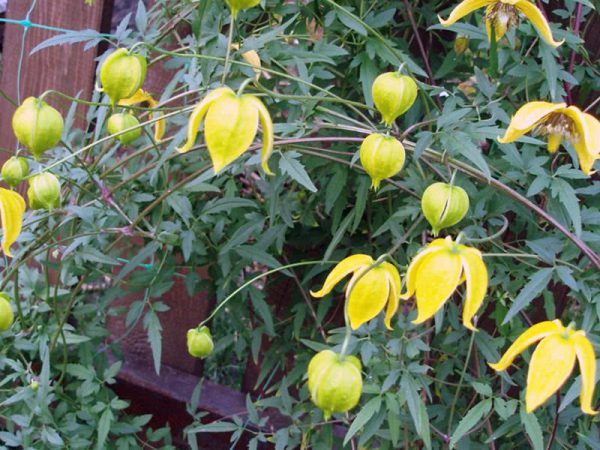
Clematis Tangut description
Powdery mildew
This is a fungal disease that manifests itself as a white coating on leaves and branches. It is treated by spraying with fungicides: Bayleton, Quadris, Skor, Topaz, Tilt. Processing is carried out twice with an interval of 2-3 weeks.
Gray rot
The sources are canids - fungi that live in the soil. With an increase in humidity and a lack of sunlight, they infect the plant from below, from the trunk. It will smooth out the disease like a gray fluffy bloom. It is treated with drugs: Fitosporin-M, Gamair, Alirin-B, Fundazol.
Rust
A diseased plant has red spots on the leaves, which expand and "grow". It has been proven that juniper can become the main source of infection. Rust is treated with preparations based on sulfur, Bordeaux liquid or urea.
Wilt
Wilt or wilting of clematis is caused by fungi from the genus Phomopsis. The tops of the shoots wither, die off, then all the shoots die. It is important to notice the disease at an early stage, remove all affected areas, treat the bush with drugs: Fundazol, copper sulfate, potassium permanganate.
Aphid
These pests are easy to spot in the leaf axils and buds. They suck the juices out of the plant, preventing it from growing normally. The best remedy in the fight against aphids is digester soap and Biotlin. Also, the plant is sprayed with a solution of kerosene or infusion of onion peels.
Gall nematode
These are microscopic worms that reproduce in the roots of the plant.Their numerous colonies are capable of destroying even an adult bush. The main problem is the late detection of pests. Usually, symptoms appear even when it is impossible to help clematis. It has to be destroyed, and the ground under it must be thoroughly disinfected several times.
Use in landscape design
Tangut clematis is used to decorate gazebos, arches and facades. The support for the bush should be as strong as possible, so walls and metal arches and pillars of gazebos are preferable to plastic mesh. The plant grows rapidly, braiding any surface in a few weeks.
Clematis with bell flowers looks good in joint compositions with roses, hydrangeas, decorative grape varieties with colorful leaves. The combination of several varieties gives an unusual effect and is used by many gardeners.
Testimonials
This type of clematis is widespread in different latitudes and is loved for its unpretentiousness, immunity stability and ease of reproduction. People celebrate its ability to endure the coldest winters. Many positive reviews also relate to the decorativeness of the species and the unusualness of its colors.
The Tangut view is rightfully considered one of the best. The plant has many positive properties, while it does not need complex care. Lush bloom even after frosty winters and disease resistance make the species very popular among gardeners in different countries.

